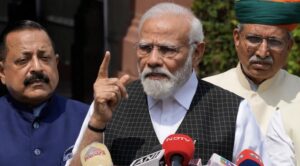In official media, the Indian government has replaced its usual name India with an older Sanskrit phrase. This has raised questions about whether there are plans to change it.
In an invitation to a G20 summit dinner, Prime Minister Narendra Modi was called “Prime Minister Bharat”, signaling a desire to abandon the term “India.”
Within the country, the terms “India” or “Bharat”, are interchangeable. However, both nationally and internationally “India” is much more commonly used.
Modi’s Hindu Nationalist Movement is using “Bharat”, on international invitations, to indicate that it wants to abandon the term “India”. This aesthetic choice is seen by many of Modi’s supporters as crucial for decolonization.

On Tuesday, Chief Minister Pushkar Singh Dhami of Uttarakhand wrote on social media: “Another knock against slavery mentality.” The regional official described the use of the word “Bharat,” on the invitation as a “proud and proud moment for all countrymen.”
“Long Live Mother Bharat!” He added.
Shashi Tharoor, a member of parliament, questioned nationalists’ intentions and urged India to keep both names.
Tharoor wrote: “While there’s no constitutional problem with calling India Bharat (which is one of two official names), I hope that the government won’t be so stupid as to totally dispense with the name ‘India’, which has an incalculable value that’s been built over centuries.”

He said, “We should keep using both words, rather than give up our claim to an old name, one that is known around the globe.”
The origins of the word “India” are complex and have evolved over many thousands of years.
The ancient Greeks named the region “Indos”, which is thought to be a transliteration of the word “Hindi”. Other cultures started linguistically associating the area with the Indus River.
In the first paragraph of Article 1 of India’s Constitution, it states: “India (Bharat) shall be a Union of States.”




